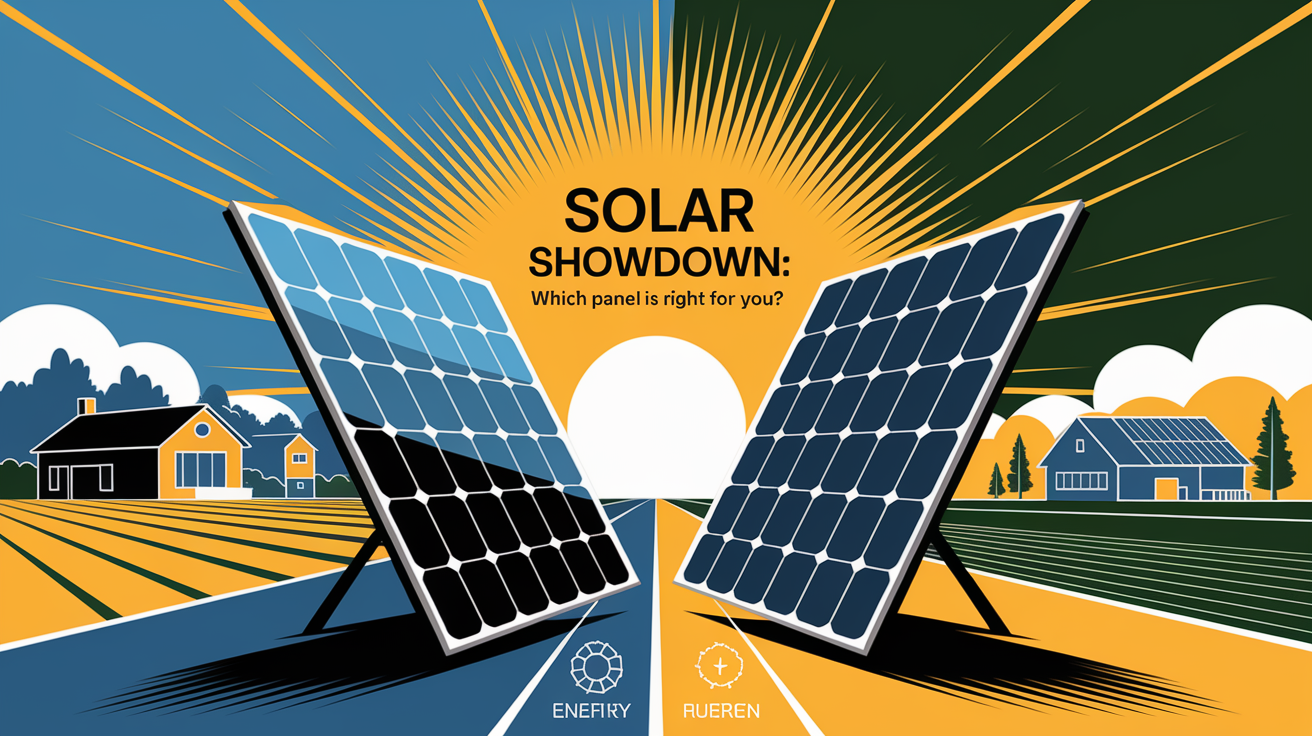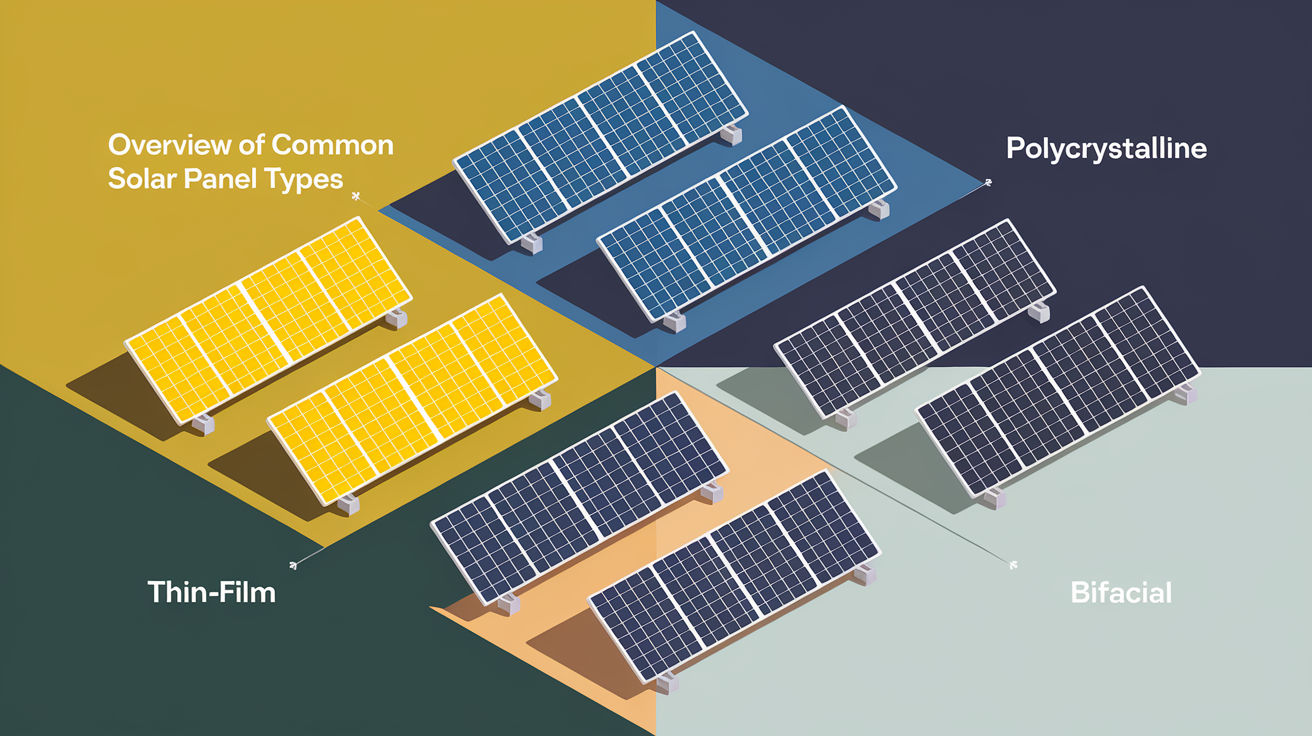Solar Panel Types Comparison: Choosing the Best Fit for Your Needs
Solar Showdown: Which Panel is Right for You?
Selecting the optimal solar panel unlocks maximum power output, minimizes long-term costs, and aligns your installation with sustainability goals. From high-performance residential rooftops to flexible, off-grid camping kits, each photovoltaic (PV) technology brings unique strengths. This guide cuts through the noise—highlighting real-world benefits, proven performance metrics, and clear cost/value trade-offs—so you can make a confident, data-driven decision.

Overview of Common Solar Panel Types
The solar market centers on three established categories plus emerging variations designed to push efficiency boundaries:
- Monocrystalline Solar Panels
Constructed from single-crystal silicon, monocrystalline panels deliver up to 22% efficiency and have a slim profile—ideal for space-constrained rooftops. They command a premium price due to higher silicon purity and energy-intensive manufacturing. Learn more about their pros and cons on SolarReviews.
- Polycrystalline Solar Panels
Formed by casting multiple silicon fragments together, these panels typically achieve 15–17% efficiency at a lower cost per watt. Their blue-speckled appearance reflects slightly reduced electron flow, but they remain a solid choice for budget-sensitive projects. Detailed comparisons can be found on EnergySage.

Overview of Common Solar Panel Types - Thin-Film Solar Panels
Using layers of photovoltaic material—such as amorphous silicon (a-Si), Cadmium Telluride (CdTe), or Copper Indium Gallium Selenide (CIGS)—deposited on glass or flexible substrates, thin-film panels offer lightweight form factors and versatility. Efficiency ranges from 10% to 13%, offset by significantly lower production costs and suitability for curved surfaces.
- PERC Solar Panels
Passivated Emitter and Rear Cell (PERC) technology adds a rear-side passivation layer to traditional crystalline panels, boosting energy capture by 1–1.5%. PERC modules reach 20–21% efficiency and strike a balance between cost and performance. Explore their mechanics on EcoFlow.
Efficiency and Performance
Efficiency drives how much electricity a panel converts from available sunlight. High-efficiency modules maximize output on limited roof space and improve ROI:

- Monocrystalline: Up to 22%, thanks to uniform silicon purity and tight crystal structure. Top-tier brands like SunPower and Panasonic push toward 22–23% with advanced cell architectures.
- Polycrystalline: 15–17% efficiency; cost-effective but larger arrays are necessary to match monocrystalline output.
- Thin-Film: 10–13%; excels in low-light and high-temperature conditions due to a lower temperature coefficient (–0.25%/°C vs. –0.35%/°C for crystalline).
- PERC and Advanced Cells: PERC modules average 20–21%. Cutting-edge N-type heterojunction (HJT) and TOPCon panels surpass 24%, yet remain at a premium price tier. (Source: PowerOutage.us)
Temperature Coefficient and performance in low light vary by technology—thin-film often outperforms crystalline in overcast conditions, while monocrystalline retains higher output in direct sun.
Cost and Value
Panel pricing hinges on material, fabrication complexity, and brand premium:

- Monocrystalline: $0.30–$0.40 per watt installed; higher upfront cost offsets through superior solar panel efficiency and long-term yield, delivering a stronger ROI over a 25+ year lifespan.
- Polycrystalline: $0.25–$0.30 per watt; lower manufacturing waste and simpler melting processes reduce cost but yield lower annual energy production.
- Thin-Film: $0.20–$0.25 per watt; cheapest per square meter but requires 15–25% more area for equivalent output. Ideal for utility-scale or integrated building applications.
- PERC: $0.32–$0.38 per watt; incremental cost increase over standard crystalline panels justified by 5–10% more energy harvest annually. (Source: EnergySage)
Evaluate total cost of ownership: include installation, inverter compatibility, maintenance, and warranty terms (often 25 years for power output). Detailed cost vs. efficiency insights appear on SolarReviews.
Durability and Maintenance
Longevity and warranty service protect your investment. Key considerations:
- Lifespan: Most crystalline panels come with a 25-year performance warranty, retaining at least 80% of nameplate capacity. Thin-film modules often carry 10–20 year warranties but offer less predictable degradation curves.
- Panel Degradation: Monocrystalline and PERC panels degrade at ~0.3–0.5% per year. Cadmium Telluride thin-film degrades slightly faster in high-humidity environments.
- Maintenance: All PV systems require periodic cleaning and inverter checks. Bifacial solar panels—which collect light from both sides—may demand specialized racking to optimize reflected irradiance.
- Warranty and Service: Leading manufacturers like LG Solar, Trina Solar, and SunPower offer robust product and performance warranties, simplifying claim processes if output dips below guarantees.
Aesthetic and Space Considerations
Visual impact and roof real estate shape panel choice:
- Black-on-Black Aesthetics: Premium monocrystalline panels with backsheet and frameless designs deliver sleek, uniform appearances.
- Solar Shingles: Integrate seamlessly with traditional roofing; ideal for homeowners prioritizing curb appeal, though cost per watt can be 50–70% higher than rack-mounted modules.
- Space Efficiency: For limited rooftops, high-efficiency monocrystalline or HJT modules maximize power per square meter. Polycrystalline suits larger roofs where minor efficiency sacrifices are acceptable.
- Flexible Thin-Film: Enables installation on curved surfaces, RVs and camping equipment. Their low weight (under 3 kg/m²) eases mounting on non-structural supports.
Environmental Impact
Assess cradle-to-grave carbon footprint and recyclability:
- Energy Payback Time: Crystalline silicon panels typically recoup manufacturing emissions in 1–2 years of operation; thin-film can return energy investment in under a year.
- Material Sustainability: Cadmium Telluride (CdTe) and CIGS modules use rare or toxic elements requiring specialized recycling protocols. Silicon-based panels boast an established recycling chain for glass and aluminum frames.
- End-of-Life Management: Leading brands fund take-back programs. Confirm inverter compatibility and recyclability in vendor specifications to minimize your project’s ecological footprint.
Matching Panel Types to Common Scenarios
Customize your selection based on real-world use cases:
- Residential Rooftops: Monocrystalline or PERC panels deliver high solar panel efficiency per roof area. Brands like Panasonic and SunPower cater to homeowners seeking top-tier warranties and aesthetics.
- Commercial Installations: Polycrystalline panels from Trina Solar offer cost-effective scalability for warehouses and large floor-mounted arrays where space is abundant.
- Utility-Scale Farms: Thin-film modules reduce upfront capex. Their lower temperature coefficient improves yield in hot climates.
- Off-Grid and Portable Power: Flexible CIGS or amorphous silicon thin-film panels power RVs and remote telecommunication sites, providing lightweight, bendable solutions.
Powering Your Decision: Final Takeaways
Balancing efficiency, cost, durability, and aesthetics will guide you to the right panel type:
- Prioritize monocrystalline or PERC for maximum ROI on limited roof space.
- Choose polycrystalline when upfront budget constraints outweigh minor efficiency losses.
- Deploy thin-film in large-scale or weight-sensitive applications, or when flexible form factors matter most.
- Factor in temperature coefficients, warranty length, and potential panel degradation to forecast 25-year performance.
- Confirm inverter compatibility and rack design if selecting bifacial arrays or solar shingles.
By aligning technical specifications with your project’s real-world requirements—space, budget, climate, and aesthetic goals—you’ll secure a solar solution that delivers consistent energy production, robust warranties, and measurable sustainability benefits.







